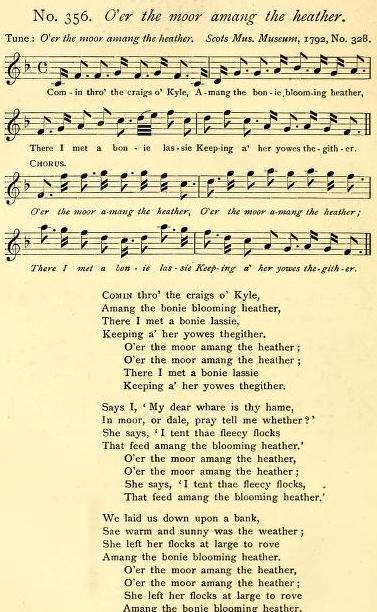The Laird o' Drum- Laidlaw (MI) 1916 Gardner
[Both the extant US ballads labeled versions of Laird o Drum are associated with the 1792 Burns re-composition, "O'er the Moor Amang the Heather," originally by the Scottish Jean Glover of Kilmarnock, which according to Alan Cunningham became popular in 1790. The third verse appears in both US versions. The Michigan text is identical to the verses of "O'er the Moor" (see below) and should not properly be called a version of Child 236.
According to Elizabeth Gardner and Geraldine Chickering: "The Child version of "The Laird o' Drum," to which the Michigan text is similar, contains three stanzas of four lines each, taken from Johnson's Musical Museum, No. 397, p. 410 (Child, IV, 332)."
If you compare the text in Child's Appendix; Johnson's Museum, No 397, p. 410 (see text below) it is evident that the Michigan text is not the same and there is really no comparison except they both have three stanzas!
Child's Appendix: Johnson's Museum, No 397, p. 410.
As I went out ae May morning,
A May morning it chanc'd to be,
There I was aware of a weelfar'd maid,
Cam linkin oer the lea to me.
O but she was a weelfar'd maid,
The bonniest lass that's under the sun;
I spier'd gin she could fancy me,
But her answer was, I am too young.
'To be your bride I am too young,
To be your loun wad shame my kin;
So therefore, pray, young man, begone,
For you never, never shall my favour win.'
R. Matteson 2013]
Burns Re-composition 1792:

From: Ballads and Songs of Southern Michigan- A Collection of 200+ traditional & folk songs & variations with commentaries by Emelyn - Elizabeth Gardner and Geraldine Jencks Chickering, Include Lyrics & Sheet music. Ann Arbor: The University of Michigan Press London: Humphrey Milford, Oxford University Press : 1939
THE LAIRD O' DRUM
(Child, No. 236)
In The Songs of Scofland Pnor to Burns, edited by Robert Chambers (Edinburgh and London, 1862), pp. 440-441, there is a song with identical words, a tune, and a footnote (p 441) which reads: "This song is said to have been the composition of a woman named Jean Glover, who, strange to say, had deserted respectable, humble Scotch life, to accompany a very poor band of strolling players. Burns tells us, "I took the song down from her singing, as she was wandering through the country with a sleight-of-hand blackguard." The Child version of "The Laird o' Drum," to which the Michigan text is similar, contains three stanzas of four lines each, taken from Johnson's Musical Museum, No. 397, p. 410 (Child, IV, 332). For one stanza almost identical with stanza 3 of the Michigan text see Barry, Eckstorm, and Smyth, p. 300. The present version was sung in 1916 by Mr. John Laidlaw, Ypsilanti.
1 A-coming o'er the crags o' Kyle
And through amang the blooming heather,
There I met a bonnie lass
Was keeping a' her ewes together.
2 Her head it was so finely drest
Adorned wi' hat and feather;
Her plaid hung loose about her waist,
Came sweeping through amang the heather.
3 Says I, "My lass, where is your hame,
In maur or dale, come tell me whither?"
She says, "I tend the fleecy flocks
That feed amang the blooming heather."